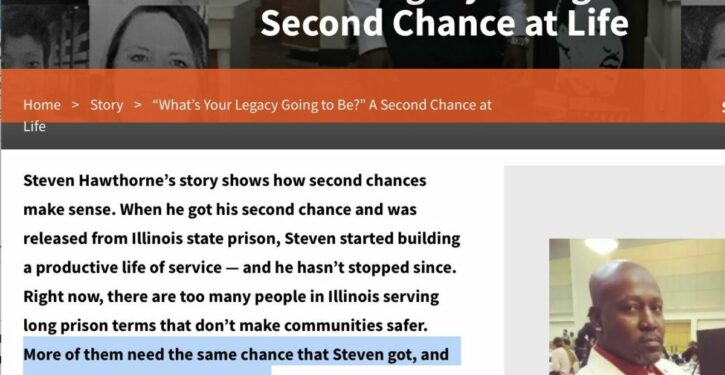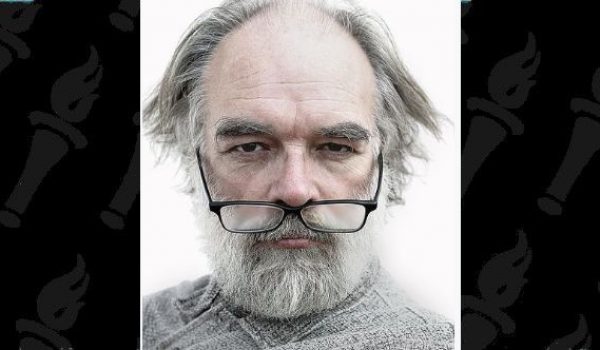
“A murderer was released early, celebrated by soft-on-crime groups, then charged with two more killings. Tragic and completely avoidable,” notes Senator Tom Cotton. Now, soft-on-crime groups are hiding the fact that they ever supported his release, even as they continue to push for legislation that enables the release of inmates who have committed murder.
“FAMM Foundation…praised the convicted murderer. They argued that ‘more [prisoners serving long sentences] need the same chance.’ Groups like FAMM won’t have empathy for the victims. Only for the killers,” Cotton observes.
“Cook County prosecutors accuse Steven Hawthorne — a former example of successful inmate reentry into society — of committing a grisly new double homicide of an ex-girlfriend and her new beau,” reports the Chicago Tribune. Hawthorne murdered two people in 1983 and was given life without parole, but later, he was given the opportunity to seek parole, which was granted in 2017.
There are many examples of murderers killing again after being released. At the age of 19, while on parole, Kenneth McDuff shot and killed two boys, then killed a girl after raping her and torturing her with burns and a broomstick. After being paroled years later at the age of 43, he murdered additional women — as many as 15 women in several states.
The Western Journal describes the recent killings by a man criminal-justice reformers depicted as a shining success story:
A convicted murderer who was sentenced to life in prison without the possibility of parole in 1984 is accused of killing two people earlier this week in a brutal Chicago double murder.
That line in and of itself tells a story of something that went terribly wrong: People who are sentenced to spend their natural life behind bars generally are not in a position to commit such crimes.
That was not the case for 55-year-old convicted murderer Steven Hawthorne, who should have been in prison last Sunday morning but was instead allegedly menacing a Windy City neighborhood and taking more human life.
In 1983, at age 17, Hawthorne fatally shot a young man during an altercation. An innocent bystander who was playing chess nearby also took a bullet and died….In 2017, Hawthorne was up for parole and was released from an Illinois state prison.
The local media celebrated him as a man who had received a second chance at life, which he had callously denied to others. A February 2017 Facebook post from The Chicago Tribune shows a smiling 49-year-old Hawthorne after he was freed….The nonprofit criminal justice reform advocacy group Families Against Mandatory Minimums also dedicated an entire page to Hawthorne on its website.
“Steven Hawthorne’s story shows how second chances make sense,” FAMM said of the killer. “When he got his second chance and was released from Illinois state prison, Steven started building a productive life of service — and he hasn’t stopped since.”
The page went on and on about Hawthorne’s life and what he intended to do with his freedom — until it didn’t.
FAMM removed its page for Hawthorne sometime this week. Without an explanation, it was simply deleted.
Thankfully, the page was archived, so it can still be accessed here.
Why would FAMM remove its page celebrating the success of Hawthorne’s release from prison?
It might have something to do with what he was accused of doing on Sunday morning.
WLS-TV reported Hawthorne allegedly entered the Chicago home of 26-year-old Tamera Washington, her two young daughters, her 63-year-old uncle, and her boyfriend, Norman Redden.
Police say that Redden was shot in the head and died and that Hawthorn also fired shots at the uncle and the little girls.
Hawthorne then allegedly shot Washington in the arm before he pistol-whipped her. She was able to get away, but officers said the convicted murderer caught up with her down the street and murdered her by beating her over her head with a “boulder.”
In another twist, Hawthorne was not just out of prison for a previous double murder. He was out on bail after he was arrested by police in January during a traffic stop while allegedly possessing a handgun as a felon.
FAMM supports not just parole for murderers, but also “second-look” laws that release killers and serial rapists even if they would not otherwise be eligible for parole. Supporters of second-look laws such as FAMM misleadingly depict second-look legislation as a way of releasing “extraordinary” inmates who have a “truly exemplary record of achievement while incarcerated” and “have successfully rehabilitated” themselves.
But that is misleading, because most murderers seeking release under Washington, DC’s second-look law have been released, not just the ones who were successfully rehabilitated. Second-look laws allow many unsavory killers to be released, even when they go on to commit more crimes. In Washington, DC, 82% of inmates seeking release have been released under its recently-enacted second look law. As the Washington Post reported on February 1, “So far, D.C. judges have ordered the release of 135 people under the law….Twenty-nine requests were denied, according to the data. Of those released, the majority had been convicted of murder.” The Post was discussing this in a news story about a rapist who is seeking release even though he raped three women and forced the victims to dig their own graves.
Murderers who are released sometimes return to a life of crime. DC’s second look law has already “has led to 135 defendants being released early, of whom 28 have been rearrested,” according to the Daily Caller. That’s a 21% reoffense rate, even though most of those released inmates were released very recently (in 2022 or 2023), and reoffense rates rise over time as more and more inmates return to a life of crime. For example, when the U.S. Sentencing Commission looked at reoffense rates for released inmates over a longer 8-year period, it found that violent offenders returned to crime at a 63.8% rate. Even among those over age 60, 25.1% of violent offenders were rearrested.
Supporters of second-look laws have falsely claimed inmates can safely be released by their late 30s. For example, the Law Enforcement Action Partnership, which is funded by left-wing billionaire George Soros‘ foundation, has mistakenly claimed that keeping people in prison who were sent there “a decade ago” does “very little, if anything, to maintain safety.”
But experts say many inmates do not age out of crime, even when they reach their 50s or 60s. A transgender murderer killed again at age 83, after two prior murder convictions, and being allowed to stay in a women’s shelter despite previously killing two women. Many criminals commit more murders or violent crimes decades after they were first sent to prison. At the age of 76, Albert Flick murdered a woman, stabbing her at least 11 times while her twin children watched. He had earlier spent 25 years in prison for killing his wife by stabbing her 14 times in front of her daughter
A lobbyist for a second look bill in Virginia, which passed the state senate but then died in the House of Delegates, predicted it would release so many inmates that it would empty two Virginia prisons, under a conservative estimate. That could increase the crime rate by shrinking the average amount of time served: Shorter sentences are less of a deterrent to committing crimes. Studies of two California laws indicate that longer sentences deter some crimes, by making it more costly to commit a crime. Letting inmates out of prison early can increase the crime rate, even when the inmate being released is no longer dangerous. It sends a message to would-be offenders that they won’t face harsh consequences for committing a crime, as long as they later behave well enough in prison to get released early.
Second-look legislation has been described by journalists like Kerry Dougherty as an end-run around restrictions on parole. But Second Look legislation lacks the safeguards and consistency of the parole system. Parole boards apply consistent standards to all offenders in a state. But Second Look petitions are ruled on by hundreds of different judges who have different ideas about when to release inmates.
Supporters of second-look laws argue that “everyone deserves a second chance.” But as a critic noted, “most inmates doing more than 15 years have already had their second, third, fourth, and fifth chances — the typical released state prison inmate has five prior convictions, according to Rafael Mangual, who studies the criminal-justice system at the Manhattan Institute.”



